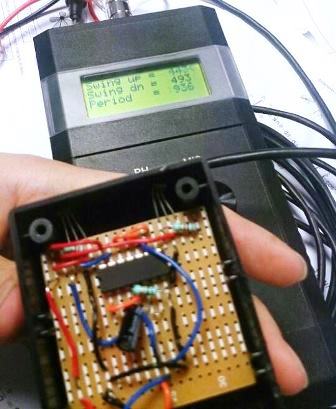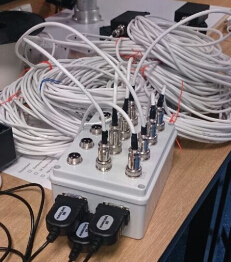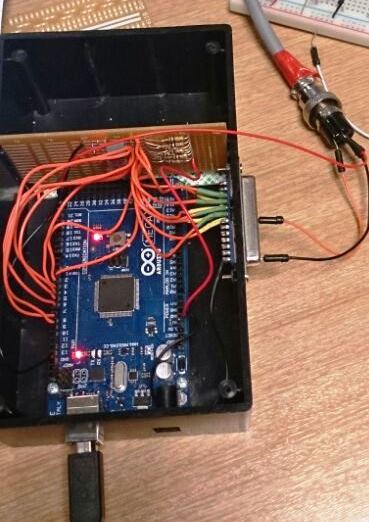Difference between revisions of "Projects:2014S1-06 Bell Ringing Robot: Hawkear"
(→Project Aims) |
(→System Component) |
||
| Line 21: | Line 21: | ||
* Sensor Box | * Sensor Box | ||
[[File:SensorBoxtest1.jpg]] | [[File:SensorBoxtest1.jpg]] | ||
| + | The sensor box consists with a jiffy box (80Lx60Wx30Hmm), a 4-pin male connector and a PCB board with the sensor circuit. | ||
| + | The sensor box circuit consists with two parts: a monostable circuit and a NAND-gate latch. The Mono-stable circuit is used for Odd Struckness Meter. The NAND-gate latch is used for analyse box and Abel bell ringing simulator. | ||
* Junction Box | * Junction Box | ||
[[File:JunctionBox2.jpg]] | [[File:JunctionBox2.jpg]] | ||
| + | |||
* Analysis Box | * Analysis Box | ||
[[File:AnalysisBox.jpg]] | [[File:AnalysisBox.jpg]] | ||
Revision as of 19:28, 29 October 2014
Contents
Project information
Motivation and Background
Change-Ringing has a history of nearly 700 years. It is a highly mathematical collaborative team sport and musical performance. The objective of this project is to work towards a fully autonomous robot which can ring with a team made up of robots and humans to achieve high quality ringing, using audible clues to maintain control of the bells. Hawkear is a new computer system designed to help the judges in bell ringing contests in the same way "Hawkeye" helps as referees. As the first year of this long term project, the main goal is to use Hall effect sensors build a bell striking analysis system which is comparable to David Bagley’s system, should be able to connect with PC interface, the Odd Struckness Meter and detect the strike motion.
Project Aims
The project aims to develop a bell striking analysis system, which is capable of:
- Sensor induction
When the hall sensor is triggered, the sensor box should be able to send the signal through the 12.5-meter cable. The cable can plug into Bagley's Odd Struckness Meter. OSM allows accurate measurements to be made of the swing times of a bell and its clapper. The data can be used to help minimise oddstruckness[1]. The OSM also shows which bells in a ring need adjusting, and by how much it need to be adjusted[1].
- Data acquisition
By connecting the junction box to the Abel interface, the Abel interface can record the data information of each bell. The junction box also can connect with the analysis box, the program in the Aduino board can calculate the head strike time and the back strike time of each bell. Those data can be used for analysis the ringer's performance.
- Data analysis for bell ringing contest and training.
By calculating and comparing the data with the standard data of each bell, the system can estimate if there is an error or it is a perfect strike.
System Component
- Sensor Box
 The sensor box consists with a jiffy box (80Lx60Wx30Hmm), a 4-pin male connector and a PCB board with the sensor circuit.
The sensor box circuit consists with two parts: a monostable circuit and a NAND-gate latch. The Mono-stable circuit is used for Odd Struckness Meter. The NAND-gate latch is used for analyse box and Abel bell ringing simulator.
The sensor box consists with a jiffy box (80Lx60Wx30Hmm), a 4-pin male connector and a PCB board with the sensor circuit.
The sensor box circuit consists with two parts: a monostable circuit and a NAND-gate latch. The Mono-stable circuit is used for Odd Struckness Meter. The NAND-gate latch is used for analyse box and Abel bell ringing simulator.
- Junction Box
- Analysis Box
Team
Group members
- Mr Yapeng Xie
- Mr Zhenhao Zhang
Supervisors
- Dr Mathew Sorell
- Dr Branden Philips
Resources
- The Odd Struckness Meter (OSM)
- Standard PC
References
- [1] David Bagley system introduction,[Online],Available: http://www.ringing.demon.co.uk/able/ableface.htm
- [2] The Hall Effect Sensor, Electromagnetism,[Online],Available: http://www.electronics-tutorials.ws/electromagnetism/hall-effect.html

